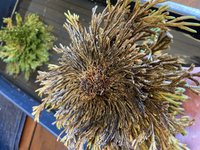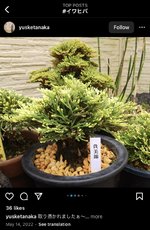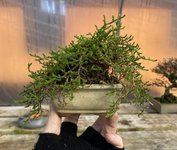Viridian Bonsai
Yamadori
This is a plant species that is noticeably absent in the West when it comes to Bonsai. Iwahiba (Selaginella tamariscina) is a spicies of spike moss native to China, Korea, the Russian Far East, and Japan. During dry seasons it can survive complete desiccation with the foliage fronds curling up into the centre to conserve moisture and protect the crown.
As bonsai, iwahiba doesn’t fit any particular style but does form somewhat of a trunk that looks strange and quite intriguing. Iwahiba translates to rock cypress in English with it naturally growing in rock pockets in Japan and it’s foliage bearing close resemblance to cypress fronds.
I purchased my 5 plants from AliExpress in a bundle from China and they came completely dry and desiccated with barely any roots. This somewhat concerns me since a few resources online say that these plants may take a long time to become healthy again after being totally dried out and that it is important that the woody part at the base is intact to grow new roots.
After soaking them in water for 16 hours they have greened up considerably and look quite alive again! I was amazed how they went from a light brown colour to a forest green after just being rehydrated for less than a day! They also opened up from their dry, round balls into brilliant rosettes!
Now, I’m scouring the internet for the best way to grow them. Most Japanese YouTube videos will show them planted in straight akadama with a moss top dressing to keep mousture. Most sources say that they also grow extremely slowly and take a very long time to form that strange, dark trunk.
I’ve started this thread to see if others have experience with this type of plant and to gain advice on the best way to grow them!
Below I attached images of what they looked like when I opened the package, after 16 hours soaking in water, and the woody base that the roots grow from. I also added a few images from instagram to show what they can look like as bonsai!
Thanks!
Ty Biswanger
As bonsai, iwahiba doesn’t fit any particular style but does form somewhat of a trunk that looks strange and quite intriguing. Iwahiba translates to rock cypress in English with it naturally growing in rock pockets in Japan and it’s foliage bearing close resemblance to cypress fronds.
I purchased my 5 plants from AliExpress in a bundle from China and they came completely dry and desiccated with barely any roots. This somewhat concerns me since a few resources online say that these plants may take a long time to become healthy again after being totally dried out and that it is important that the woody part at the base is intact to grow new roots.
After soaking them in water for 16 hours they have greened up considerably and look quite alive again! I was amazed how they went from a light brown colour to a forest green after just being rehydrated for less than a day! They also opened up from their dry, round balls into brilliant rosettes!
Now, I’m scouring the internet for the best way to grow them. Most Japanese YouTube videos will show them planted in straight akadama with a moss top dressing to keep mousture. Most sources say that they also grow extremely slowly and take a very long time to form that strange, dark trunk.
I’ve started this thread to see if others have experience with this type of plant and to gain advice on the best way to grow them!
Below I attached images of what they looked like when I opened the package, after 16 hours soaking in water, and the woody base that the roots grow from. I also added a few images from instagram to show what they can look like as bonsai!
Thanks!
Ty Biswanger
Attachments
-
 CDC28B1D-88DA-443B-A099-8A0A33E22EB8.jpeg259.9 KB · Views: 85
CDC28B1D-88DA-443B-A099-8A0A33E22EB8.jpeg259.9 KB · Views: 85 -
 3797A492-1153-4F0D-9163-344B50443978.jpeg267.6 KB · Views: 71
3797A492-1153-4F0D-9163-344B50443978.jpeg267.6 KB · Views: 71 -
 444E343F-9D1C-4B28-B9F2-B385F63760C2.jpeg311.7 KB · Views: 70
444E343F-9D1C-4B28-B9F2-B385F63760C2.jpeg311.7 KB · Views: 70 -
 B1642999-6B65-4B93-9EAC-E78C639A0876.jpeg163.8 KB · Views: 68
B1642999-6B65-4B93-9EAC-E78C639A0876.jpeg163.8 KB · Views: 68 -
 65943940-CD1C-4DB9-9E4B-22C0FF76743A.jpeg307.1 KB · Views: 85
65943940-CD1C-4DB9-9E4B-22C0FF76743A.jpeg307.1 KB · Views: 85 -
 0AC93D1D-81B0-4EFC-89C8-29F4241EDF3A.jpeg157.1 KB · Views: 83
0AC93D1D-81B0-4EFC-89C8-29F4241EDF3A.jpeg157.1 KB · Views: 83 -
 AA02C8A0-B84D-4F19-A455-FFC070C8D026.jpeg166.6 KB · Views: 84
AA02C8A0-B84D-4F19-A455-FFC070C8D026.jpeg166.6 KB · Views: 84 -
 42B9FC70-48B7-46C4-8008-0EDA17857AB6.jpeg139.5 KB · Views: 72
42B9FC70-48B7-46C4-8008-0EDA17857AB6.jpeg139.5 KB · Views: 72 -
 E0E4DA8B-97A4-466C-BD5A-674840833B46.jpeg67.9 KB · Views: 75
E0E4DA8B-97A4-466C-BD5A-674840833B46.jpeg67.9 KB · Views: 75 -
 BDBBCCCE-292C-4588-B76D-FC3833ED9C14.jpeg191 KB · Views: 80
BDBBCCCE-292C-4588-B76D-FC3833ED9C14.jpeg191 KB · Views: 80


